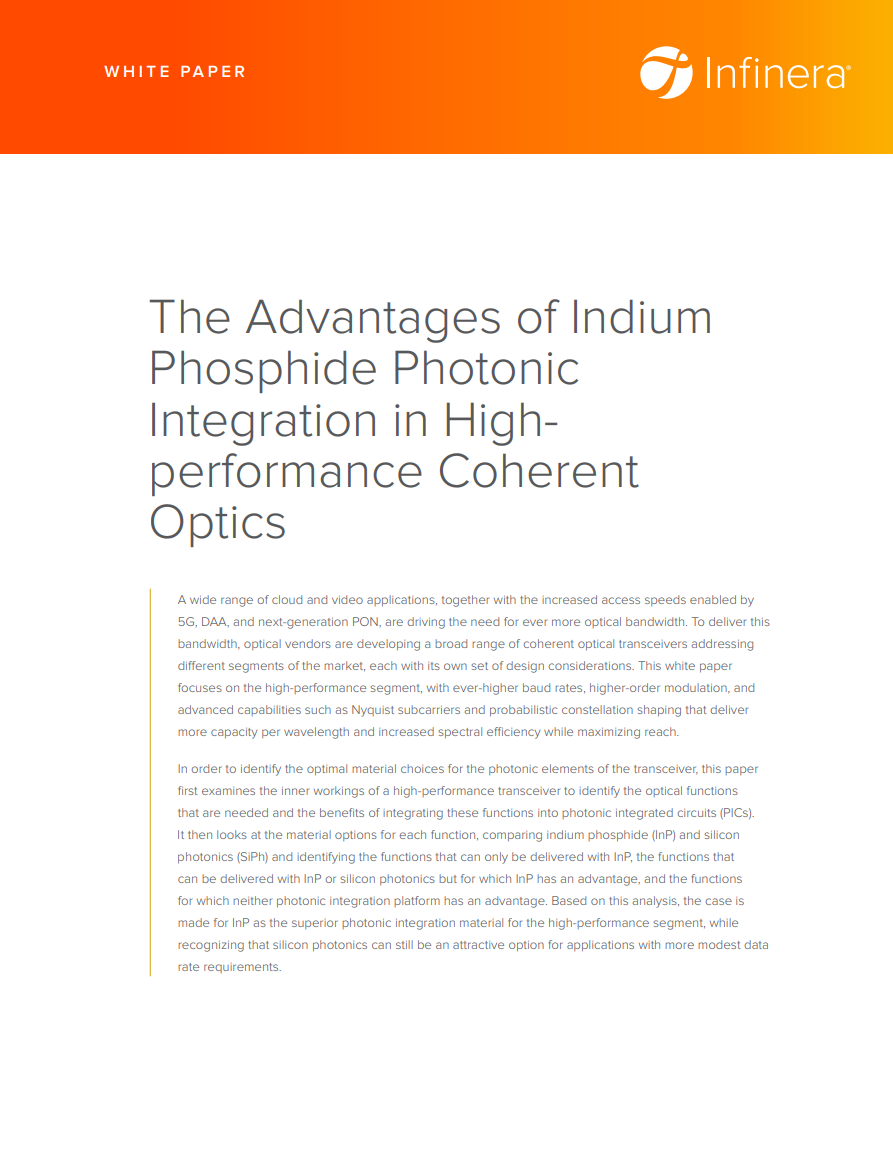To address the undeniable growing demand for higher bandwidth, optical vendors have been playing their role with the development of various coherent optical transceivers for different areas of the market, each with its own set of design considerations.
Historically, the most used material platform for the photonic integrated circuits (PICs) behind these products has been indium phosphide (InP). However, the increase of silicon photonics in recent decades has promised to disrupt the optical components industry with a common platform on which diverse optical functions can be integrated – in a way that scales easily to high volumes – while keeping manufacturing costs low.
With new developments in this area, will this ultimately start to make InP irrelevant? Not so, argues Paul Momtahan, director of solutions marketing at Infinera. ‘There’s been quite a bit of buzz about [silicon photonics] in the industry,’ he said. ’We have been asked “is this still a place for InP?” But, there are arguments for both sides of the InP/silicon photonics debate. If you look at the coherent flow bubbles, it’s maybe not quite a 50/50 split, but there are vendors using InP, particularly if they have a background and assets and InP, and their vendors are using selective atomics. We believe there’s a very clear case for InP.’
Loss and gain
Both technologies have their advantages. Silicon, for example, can provide low losses for its passive components to support manufacturing of very small photonic circuits.
However, its physical properties prohibit capabilities such as optical gain for laser or amplification functions. This means that siliconbased transceivers would require a separate, unintegrated InP-based laser and erbiumdoped fibre amplifier (EDFA), while InP-based transceivers can be built as fully integrated PICs.
This presents some obvious cost and footprint benefits to using InP, which are punctuated by the use of waveguides, rather than coupling optics when it comes to performance and power consumption, thanks to the avoidance of coupling losses.
‘One of the big differences between InP and silicon photonics,’ said Momtahan ’is how they use different physical effects to change the refractive index. InP uses the opto-electric effect and silicon photonics uses the plasmadispersion effect. The indium phosphide effect is much more efficient.’
Momtahan explained there are two things we can look at in terms of efficiency. ‘One,’ he said, ‘is how long the modulator is, and the other is how much voltage. Comparing InP with silicon photonics to get the same effect, we either need 10 times the length of modulator or 10 times the voltage. So, InP is 10 times more efficient at changing the refractive index.’
This, he added, will have a fundamental physical advantage in terms of the modulator. ’Generally, when you go to a new speed, a higher baud rate, it is typically InP that is the first material to provide the modulator for that. But both technologies are improving. Eventually silicon photonics will probably do 90+ GBd modulators, but at that stage InP will have moved on to 120+ GBd.’
Need for speed
Momtahan believes these speeds are the way in which the industry will move in terms of PICs. ‘The industry is looking at 120GBd as a next step. InP will be a key component of that in terms of the photonics, because of the aforementioned benefits. What you will see is the next generation of modulators that come after the current 90+ GBd. These will also be InP.’ As well as the provision of instant bandwidth, the benefits of any coherent technology cannot be discussed without mentioning distance. This is another area in which Momtahan believes there is a distinct advantage.
The firm partnered last year with network provider Windstream for a live network trial that successfully achieved 800Gb/s singlewavelength transmission over 730km across Windstream’s long-haul network between San Diego and Phoenix, using Infinera’s Ice6 fifth-generation coherent technology. Another successful test was performed alongside the operator Verizon, which achieved an 800Gb/s single-wavelength transmission over 667km between Nashville and Atlanta; and a 600Gb/s single-wavelength transmission over 2,283km from Atlanta to Memphis, with a loopback in Memphis.
‘It is advantageous to the industry being able to do these very-high-capacity wavelengths of long distances, that we’re doing with Ice6,’ explained Momtahan. ‘That also has significant benefits, in terms of driving down the cost-perbit, driving down the power consumption, and increasing the spectral efficiency. So that’s kind of where we’re at with the Ice6.’
High-performance
Momtahan believes that InP could be the superior photonic integration material for the high-performance segment, although he recognises that silicon photonics can still be an attractive option for applications that perhaps have more modest data rate requirements, or where vendors may not have the necessary expertise to build a fully-integrated InP-based PIC, or are unable to make the substantial investment in building their own InP manufacturing facility.
Several research groups suggest one promising path could be hybrid integration, integrating lasers on top of complex silicon photonics with the integration of silicon photonics PICs with InP PIC circuits. ‘Time will tell,’ said Momtahan. ‘There’s a little bit of a battle going on there. The silicon photonics folks are trying to catch up. We’ll see what happens. Certainly for Infinera, our future generations will be based on InP.’



